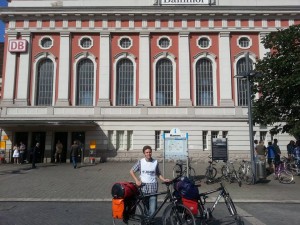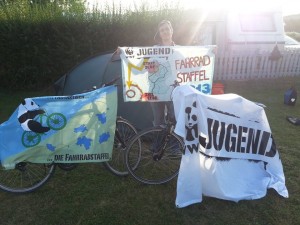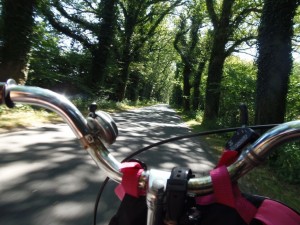‘Hands off my sausage,’ say Germans to meat-free proposal
Rice and beans instead of sausages and meat? The very idea of eathing just vegetarian fare – even if it’s just once a week – has many meat-loving Germans up in arms. Find out why.
The whole kerfuffle began earlier this week with Germany’s opposition Green Party saying they planned to roll out a weekly vegetarian day if elected. Yes, Germany is in full campaign mode with six campaign weeks left until national elections.
So, what’s the fuss about? The Greens say one day each week, workplace cafeterias at federal government institutions would be banned from serving any meat dishes or products. The environmentally-friendly party hopes that would become a model for corporate and school canteens.The party says lower meat consumption would reduce the impact of farming on the environment, lead to an increase in quality and better conditions for animals.
“A veggie day is a wonderful day to try out how to nourish oneself without meat and sausage for once,” Green Party leader Renate Künast told mass-market daily Bild this week.
But, many think otherwise. Though environmental groups have welcomed the proposal, it’s sparked uproar in the country. Some lawmakers have said it smacks of a lecturing attitude. German Agricultural Minister Ilse Aigner was quoted through a spokesman that “we don’t place much stock in paternalism. At the end of the day, we need a balanced diet and meat is part of that.”
Meat certainly is a big part of German‘s lives. Estimates suggest that per capita meat consumption in the country per year is 60 kilograms (against a global average of 42 kg per-capita annually).
A recent United Nations study suggested people in the industrialized world should halve their meat consumption, saying the demand for ever cheaper meat is ruining the planet by leading to a massive expansion of intensively farmed livestock, diverting vast quantities of grain from human to animal consumption and requiring intensive use of fertilisers, pesticides and herbicides.
But many meat-loving Germans remain unconvinced. Members of the youth wing of the Free Democrats (FDP) even organized a spontaneous street barbeque this week in front of Green Party headquarters in Berlin. Some members held up slogans saying “Hands off my sausage.”
From gray to green – biking through Germany’s former industrial heartland
In the second part of our bike blog, Maurice Jurke, who’s part of the WWF’s bike tour across Germany, takes up the story as he encounters some strenuous uphill stretches (the good thing about those, as he points out, is rolling down), sweats it out in the summer heat and cycles through Germany’s former coal-fired industrial heartland which has now been rejuvenated into a green area.
It’s 3:20 pm and I am sitting in a small café in the inner city of Hamm in the western German state of North-Rhine Westphalia. It’s quite well known in Germany and so I expected a big town with and a landscape dominated by the color gray. But as so often this year, I was wrong. Instead, I cycled on a wonderful route from Gütersloh to Hamm.
During the day, I barely rode on streets since a large part of the stretch wound through fields and large forests. I began at 10:15 as usual and I had hoped to arrive after 60 kilometers and 3 1/2 hours. But again I was proven wrong. Literally. I took some wrong turns, and so I had to ride 70 kilometers over several mountains, and arrived after 4 hours. Still a good number, but I was not very happy with my day. It was too hot and I am really thankful for my ice cream and my ice-cooled coke which I’m sipping at the moment. Still, it was a good day, it just could have been better. Well, I hope you had a perfect day. Me? I’m going to take a bath to cool down some more.
Let’ s go gray…uhh I mean green
Another day of biking through Germany and the direction is still south-west. From Hamm, we passed Dortmund and Duisburg, and now we’re visiting Langengeld, a small village at the border of Düsseldorf.
In the last three days, we’ve cycled past plenty of places in Germany’s old industrial heartland in the west. It’s called the Rhein- and Ruhrgebiet in German. There you’ll find big industrial companies and lots of mines and old coal pits. As Germany tries to change its energy policy, increasingly moving away from fossil fuels and towards renewable energy, coal is no longer a big player.
 So you’ll find many old, abandoned and derelict coal mines. In some of these places, city authorities are trying to transform them into old people’s homes. Once gray and polluting, these unpopular mines are being upcycled and are a jewel in the inner cities.
So you’ll find many old, abandoned and derelict coal mines. In some of these places, city authorities are trying to transform them into old people’s homes. Once gray and polluting, these unpopular mines are being upcycled and are a jewel in the inner cities.
That means almost our entire bike route now goes through parks or forests, occasionally cut by some highways or an inner city. Germany, in this regard, has developed well, we think.
And here’s a personal question: what do you think of this development in Germany’s former industrial areas? Have the cities been successful? Would you want to live in this former gray area, which has now painted itself in green?
Climate change linked to more violence
 Even small changes in average temperatures or rainfall can cause people to become more aggressive and resort to violence. That’s what a new study published in Science by researchers from the University of California, Berkeley claims. The researchers say there’s a “substantial” correlation between climate and conflict, including domestic and ethnic violence.
Even small changes in average temperatures or rainfall can cause people to become more aggressive and resort to violence. That’s what a new study published in Science by researchers from the University of California, Berkeley claims. The researchers say there’s a “substantial” correlation between climate and conflict, including domestic and ethnic violence.
Their examples include an increase in domestic violence in India during recent droughts, and a spike in assaults, rapes and murders during heatwaves in the US. The researchers also say that with the current projected levels of climate change by 2050, the world is likely to be a more violent place. They estimate that frequency of violence between individual people could rise by 8 to 16 percent and conflicts between groups by as much as 28 to 56 percent.
Marshall Burke, from the University of California, Berkeley, said: “This is a relationship we observe across time and across all major continents around the world. The relationship we find between these climate variables and conflict outcomes are often very large.”
The researchers looked at 60 studies from around the world with data spanning hundreds of years. Some of the individual studies they examined looked, for instance, at whether people blow their horns more with rising temperatures or whether players at a baseball game are likely to play rougher. But they also studied rapes and murders, violence between groups such as conflicts between Hindus and Muslims in India, land conflicts in Brazil and civil wars in Africa.
The authors said that in all of the studies of modern societies they looked at, higher temperatures showed a correlation with rising rates of violence. Though the researchers say they do not want to attribute any single event to climate in particular, they say economic and even psychological reasons – with some studies suggesting that heat causes people to be prone to aggression – could be at play.
“One of the main mechanisms that seems to be at play is changes in economic conditions. We know that climate affects economic conditions around the world, particularly agrarian parts of the world,“ Burke said. “There is lots of evidence that changes in economic conditions affect people’s decisions about whether or not to join a rebellion, for example.”
It’s not the first time that a warming climate has been linked to climate. The United Nations has warned that the growing number of climate refugees displaced by extreme weather could lead to conflict. The UN estimates that between 150 to 200 million people will be forced to flee climate changes by 2050.
Pushing the pedals for the environment
Over four weeks, from July 21 to August 17, members of the youth organization of the World Wildlife Fund (WWF) in Germany will be cycling across the country and covering hundreds of kilometers to raise awareness about climate and environment protection. Some of the young participants will be writing for GLOBAL IDEAS from on the road with their impressions and experiences. First off, 19-year-old Denis Mesterharm, a keen environmentalist. He had to cope with a broken bike, scorching heat and an uphill ride – and all that in just the first week.
Hello everybody and welcome to the first blog article about the “WWF-Jugend Fahrradstaffel”. First, off, what exactly is a “Fahrradstaffel?” Literally translated, it’s a bicycle relay. Members of the World Wildlife Fund’s youth organization are riding their bikes from Flensburg (in northern Germany near the border to Denmark) to Freiburg (in the south of Germany near the Swiss border). It’s a 2,210-kilometer route. The aim is to raise awareness about the need to protect the climate and to promote the environmental benefits of pushing the pedals rather than taking the car, especially for short distances in daily life.
This year, there are two routes. The West route goes through the cities such as Hamburg, Hanover and the former capital Bonn. The eastern stretch will take us to Leipzig, Erfurt and the capital Berlin. Both routes will converge in Frankfurt and end in Freiburg.
And now, to the first week where I took part. The first five stages were in Schleswig-Holstein, the northernmost state in Germany. Flensburg, the start city, is located on the “Flensburger Förde,” a fjord of the Baltic Sea. The first day was catastrophic. My bicycle broke down after just a few kilometers. The bike tube exploded and so I had to cancel the first stage.
But day two was better. From Eckernförde to Preetz via Kiel –capital of Schleswig-Holstein – that was the route. It was a bright sunny day without any problems. So I started Day 3 happily to this stage. Now I had to ride to the Hansa League City, Lübek. But this stage was more difficult than the last one. There were many more hills and lakes that made the route over 60 kilometers long. Normally I’ve had to ride 45-50 kilometers each day. Besides, it was hugely hot on the day and I forgot to take enough to drink with me.
Luckily, that problem didn’t present itself the next day because the route from Lübek to Büchen involved cycling through a big forest for most of the way and I had enough to drink with me.
But on day five, I forgot my camera at home, so I wasn’t able to take any photos on the way to Hamburg. Fortunately, the stretch wasn’t that scenic because much of it led through the city.
Day 6 was my last day on the road. From Hamburg to Lüneburg. On this stage, I crossed the Elbe river on a ferry at “Zollenspieker.” It’s an ancient customs post in Hamburg dating all the way back to the Middle Ages.
Upon arriving in Lüneburg, I handed over the WWF baton, some bicycle flags and one big flag, to the service point of the German railway (Deutsche Bahn). They were to hand it over the next day to the next member of our bicycle relay who finished the stretch. Thanks for reading this blog and watch this space for further entries from other bloggers from the bike relay.
Water blog Part III – An ocean full of solutions?
In the third and final part of our blog series on water, Julian Claudi looks at initiatives, small and big, around the world that try to tackle the water crisis by advocating more sustainable and efficient uses of water but also various techniques to obtain clean water.
Let’s listen to Vandana Shiva, Indian physicist, environmental activist, recipient of the Right Livelihood Award (the ‘Alternative Nobel Prize’) and author of the book “Water Wars” summing up the problem of the water crisis in India and how it echoes the global water crisis. Shiva addresses both – communities and water companies:
So, for India – and the world – what are the ways out?
“Governments must make a concerted effort to invest inimproving water infrastructure and management […] We must also engage communities, the private sector and civil society in promoting water conservation and water reuse.”
This is Noeleen Heyzer, Executive Secretary of United Nations Economic and Social Commission for Asia and the Pacific (ESCAP), in her speech at the 2010 Asia-Pacific Water Ministers’ forum. She called for
“…the use of simple technologies such as drip agriculture, climate appropriate cropping, rainwater harvesting and grey water reuse [which] can go a long way in increasing our water eco-efficiency.”
But can the world wait for governments to finally start doing “the job” more comprehensively?
It looks like a global solution may be some way off, yet. But there are plenty of grassroots initiatives. Barefoot College in India is an example.
The Barefoot College experts are employing an impressive range of different techniques to obtain clean water: Rain water harvesting (RWH) tanks, dams, solar powered reverse osmosis (R/O) water desalination plants, wells and ponds for ground water recharge obtain clean water.
Some of these work well at a local level, but may not be feasible on large scales. In the case of reverse osmosis (R/O) water desalination plants, it would raise serious concerns:
claims Food & Water Watch, a the Washington, D.C.-based consumer rights NGO, in a special report on reverse osmosis/water desalination:
“Ocean desalination ignores the fact that the water shortages […] are not due to a lack of natural water resources, but rather to shortsighted water policy that focuses on finding new water resources instead of managing existing resources wisely.”
But more sustainable solutions may be facing an uphill struggle. Large-scale desalination is projected to become a highly traded commodity on global markets soon.
“Depleting water supplies, coupled with increasing water demand, are driving the global market for desalination technology, which is expected to reach $52.4 billion by 2020, up 320.3% from $12.5 billion in 2010.“
But even if the trading floors love desalination, the Pacific Institute, an US non-profit research institute, adds that
It recommends that
Even wastewater recycling doesn’t appear to be entirely free of side effects, as Vivian Futran, Project Manager and PhD Student at Ben Gurion University in Israel points out here:
“For example, the types of sewage treatment used historically may not remove all micro-contaminantsincluding endocrine disrupting compounds (EDCs), a class of chemicals that can affect human development and reproductive functions.”
She concludes that
“Wastewater recycling is a relatively young technology that, while helping tackle some obvious water-related problems in Israel and elsewhere, may present dangers which still have not been fully characterized.”
Sounds like more research needs to be done. But here’s another, and encouraging example:
“Countries in the Middle East, such as Israel, and Jordan, have already transformed their agriculture [with this system] “, said Stravato. But in the Sahel, drip irrigation, which is almost a minor revolution, is only just getting going.”
Another idea is to collect fog to harvest freshwater from it – a technique that requires no on-going energy input and is considered to have a positive outcome also in connection with reforestation. Have a look at some promising projects here:
Meanwhile, “Citizen Matters” an independent local collaborative online magazine in Bangalore, India’s third most populous city, reminds us that it is vital to be careful with existing water reservoirs. For instance, aquifers – soil layers holding water – should be replenished by rainwater harvesting (RWH) and must not be permanently exploited:
“We need to replenish this water as it is finite and the best method found so far is RWH. Just digging a borewe- well and exploiting all the water is an uneducated move. Use all in your power to replenish the water table mainly with RWH and this can help maintain a good source of clean and fresh water, with the future in mind. ”
A good example to close our blog series. We hope we could shed some light on the complex issue of the global water crisis and the initiatives to address it. Everywhere something can be done on various levels to improve the situation and to make sure the right to clean and fresh water for everyone doesn’t remain a theory.













Feedback